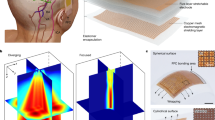Abstract
THE flow of blood in the microcirculation is of great physiological and clinical importance but, because of its complexity, the mechanism is not fully understood. Fahraeus and Lindqvist1 first observed an apparent decrease of blood viscosity when it flowed through capillaries of decreasing diameters. Their work was later confirmed2–6 and the reality of the Fahraeus–Lindqvist phenomenon was accepted. Its explanation, often attempted2,7–9, relied chiefly on the concepts of an axial concentration of red cells and/or on the effect of a plasmatic “lubricating” layer along the capillary walls.
This is a preview of subscription content, access via your institution
Access options
Subscribe to this journal
Receive 51 print issues and online access
$199.00 per year
only $3.90 per issue
Buy this article
- Purchase on Springer Link
- Instant access to full article PDF
Prices may be subject to local taxes which are calculated during checkout
Similar content being viewed by others
References
Fahraeus, R., and Lindqvist, T., Amer. J. Physiol., 96, 562 (1931).
Haynes, R. H., Amer. J. Physiol., 198, 1193 (1960).
Copley, A. L., in Flow Properties of Blood (edit. by Copley, A. L., and Stainsby, G.), 97 (Pergamon Press, 1960).
Haynes, R. H., and Burton, A. C., Amer. J. Physiol., 197, 943 (1959).
Dix, F. J., and Scott Blair, G. W., J. App. Phys., 11, 574 (1940).
Taylor, M. G., Australian J. Exp. Biol. and Med. Sci., 33, 1 (1955).
Scott Blair, G. W., Rheol. Acta, 1, 123 (1958).
Klip, W., Circulation Res., 9, 1380 (1961).
Watanabe, T., Oka, S., and Yamamoto, M., Biorheology, 1, 193 (1963).
Dintenfass, L., Exp. and Mol. Path., 4, 597 (1965).
Dintenfass, L., J. Lab. and Clin. Med., 64, 594 (1964).
Author information
Authors and Affiliations
Rights and permissions
About this article
Cite this article
DINTENFASS, L. Inversion of the Fahraeus–Lindqvist Phenomenon in Blood Flow through Capillaries of Diminishing Radius. Nature 215, 1099–1100 (1967). https://doi.org/10.1038/2151099a0
Received:
Issue Date:
DOI: https://doi.org/10.1038/2151099a0
This article is cited by
-
Physics Linkages Between Arterial Morphology, Pulse Wave Reflection and Peripheral Flow
Artery Research (2023)
-
Optical coherence tomography angiography in preclinical neuroimaging
Biomedical Engineering Letters (2019)
-
A Mathematical Model on the Consistency Coefficient of the Herschel–Bulkley Flow of Blood Through Narrow Vessel
Arabian Journal for Science and Engineering (2011)
-
Computer Modeling of Red Blood Cell Rheology in the Microcirculation: A Brief Overview
Annals of Biomedical Engineering (2005)
-
Modifications of blood rheology during aging and age- related pathological conditions
Aging Clinical and Experimental Research (1989)
Comments
By submitting a comment you agree to abide by our Terms and Community Guidelines. If you find something abusive or that does not comply with our terms or guidelines please flag it as inappropriate.



